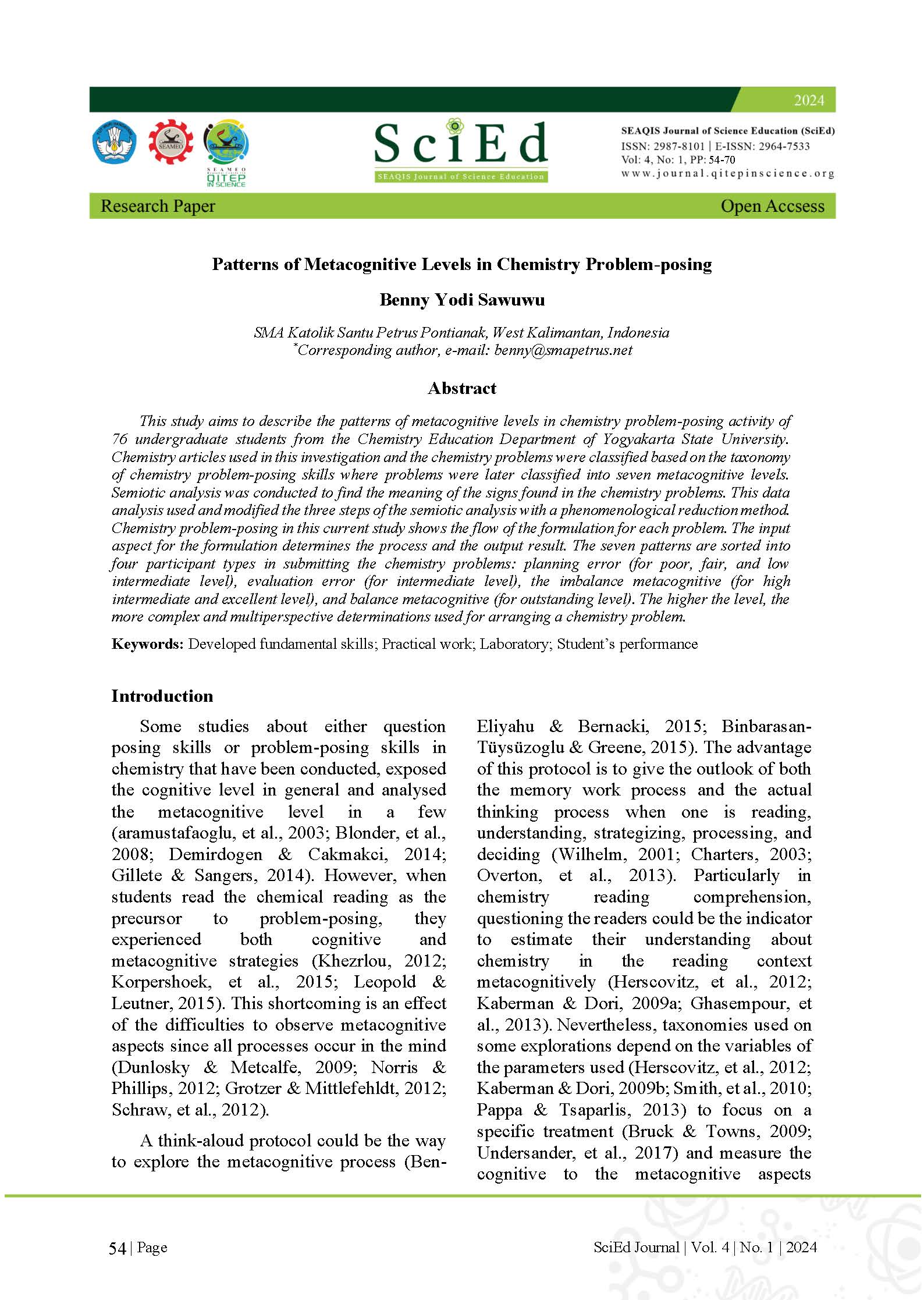Patterns of Metacognitive Levels in Chemistry Problem-posing
DOI:
https://doi.org/10.58249/sjse.v4i1.82Keywords:
Chemical equilibrium, Metacognitive pattern, Phenomenological reduction, Problem posing, Semiotic analysisAbstract
This study aims to describe the patterns of metacognitive levels in chemistry problem-posing activity of 76 undergraduate students from the Chemistry Education Department of Yogyakarta State University. Chemistry articles used in this investigation and the chemistry problems were classified based on the taxonomy of chemistry problem-posing skills where problems were later classified into seven metacognitive levels. Semiotic analysis was conducted to find the meaning of the signs found in the chemistry problems. This data analysis used and modified the three steps of the semiotic analysis with a phenomenological reduction method. Chemistry problem-posing in this current study shows the flow of the formulation for each problem. The input aspect for the formulation determines the process and the output result. The seven patterns are sorted into four participant types in submitting the chemistry problems: planning error (for poor, fair, and low intermediate level), evaluation error (for intermediate level), the imbalance metacognitive (for high intermediate and excellent level), and balance metacognitive (for outstanding level). The higher the level, the more complex and multiperspective determinations used for arranging a chemistry problem.
References
Ben-Eliyahu, A., & Bernacki, M. L. (2015). Addressing complexities in self-regulated learning: A focus on contextual factors, contingencies, and dynamic relations. Metacognition Learning, 10, 1-13. https://doi.org/10.1007/s11409-015-9134-6
Biggs, J. (1988). The role of metacognition in enhancing learning. Australian Journal of Education, 32(2), 127-138. https://doi.org/10.1177/000494418803200201
Binbarasan-Tüysüzoglu, B., & Greene, J. (2015). An investigation of the role of contingent metacognitive behavior in self-regulated learning. Metacognition Learning, 10, 77-98. https://doi.org/10.1007/s11409-014-9126-y
Blonder, R., Mamlok-Naaman, R., & Hofstein, A. (2008). Analyzing inquiry questions of high-school students in a gas chromatography open-ended laboratory experiment. Chemistry Education Research and Practice, 9, 250-258. https://doi.org/10.1039/B812414K
Bruck, A. D., & Towns, M. H. (2009). Analysis of classroom response system questions via four lenses in a general chemistry course. Chemistry Education Research and Practice, 10, 291-295. https://doi.org/10.1039/B920834H
Charters, E. (2003). The use of think aloud method in qualitative research: An introduction to think aloud method. Brock Education Journal, 12(2), 68-82. Retrieved from https://brock.scholarsportal.info/journals/brocked/home/article/download/38/38
Chopra, I., O’Connor, J., Pancho, R., Chrzanowski, M., & Sandi-Urena, S. (2017). Reform in a general chemistry laboratory: How do students experience change in the instructional approach? Chemistry Education Research and Practice, 18, 113-126. https://doi.org/10.1039/c6rp00082g
Demirdogen, B., & Cakmakci, G. (2014). Investigating students’ interest in chemistry through self-generated questions. Chemistry Education Research and Practice, 15, 192-206. https://doi.org/10.1039/C4RP00037D
Dunlosky, J., & Metcalfe, J. (2009). Metacognition. Los Angeles, LA: Sage.
Eldar, O., Eylon, B., & Ronen, M. (2012). A metacognitive teaching strategy for preservice teachers: Collaborative diagnosis of conceptual understanding in science. In A. Zohar dan Y. J. Dori (Eds.). Metacognitive in science education: Trends in current research (pp. 225-250). Dordrecht: Springer. https://doi.org/10.1007/978-94-007-2132-6_10
Favieri, A. G. (2013). General metacognitive strategies inventory (GMSI) and the metacognitive integrals strategies inventory (MISI). Electronic Journal of Research in Educational Psychology, 11(3), 831-850. http://dx.doi.org/10.14204/ejrep.31.13067
Flavell, J. H. (1979). Metacognition and cognitive monitoring: A new area of cognitive–developmental inquiry. American Psychologist, 34(10), 906-911. https://doi.org/10.1037/0003-066X.34.10.906
Ford, C. L., & Yore, L. D. (2012). Toward convergence of critical thinking, metacognition, and reflection: Illustrations from natural and social sciences, teacher education, and classroom practice. In A. Zohar dan Y. J. Dori. (Eds.), Metacognitive in science education: Trends in current research, (pp. 251-271). Dordretch: Springer. https://doi.org/10.1007/978-94-007-2132-6_11
Ghasempour, Z., Bakar M. N., & Jahanshahloo, G. B. (2013). Innnovation in teaching and learning through problem-posing tasks and metacognitive strategies. International Journal of Pedagogical Innovations, 1(1), 53-62. Retrieved from https://journal.journals.uob.edu.bh//Article/ArticleFile/158
Gilbert, J. K., & Treagust, D. F. (2009a). Introduction: Macro, submicro, and symbolic representations and the relationship between them: Key models in chemical education. In J. K. Gilbert & D. F. Treagust (Eds.), Multiple representations in chemical education (pp. 1-8). Dordrecht: Springer. https://doi.org/10.1007/978-1-4020-8872-8_1
Gillette, G., & Sanger, M. J. (2014). Analyzing the distribution of questions in the gas law chapter of secondary and introductory college chemistry textbooks from the United States. Chemistry Education Research and Practice, 15, 787-799. https://doi.org/10.1039/c4rp00115j
Goh, C. (2008). Metacognitive instruction for second language listening development: Theory, practice and research implications. RELC Journal, 39(2), 188-213. https://doi.org/10.1177/0033688208092184
Grotzer, T. & Mittlefehldt, S. (2012). The role of metacognition in students’ understanding and transfer of explanatory structures in science. In A. Zohar dan Y. J. Dori (Eds.), Metacognitive in science education: Trends in current research (pp. 79-99). Dordretch: Springer. https://doi.org/10.1007/978-94-007-2132-6_5
Herscovitz, O., Kaberman, Z., Saar, L., & Dori, Y. J. (2012). The relationship between metacognition and the ability to pose questions in chemical education. In A. Zohar & Y. J. Dori. (Eds.), Metacognitive in science education: Trends in current research (pp. 165-195). Dordretch: Springer. https://doi.org/10.1007/978-94-007-2132-6_8
Kaberman, Z & Dori, Y. J. (2009a). Metacognition in chemical education: Question posing in the case-based computerized learning environment. Instructional Science, 37(5): 403-436. https://doi.org/10.1007/s11251-008-9054-9
Kaberman, Z & Dori, Y. J. (2009b). Question posing, inquiry, and modeling skills of chemistry students in the case-based computerized laboratory environment. International Journal of Science and Mathematics Education, 7(3), 597-625. https://doi.org/10.1007/s10763-007-9118-3
Karamustafaoglu, S., Sevim, S., Karamustafaoglu, O., & Cepni, S. (2003). Analysis of Turkish high-school chemistry-examination questions according to Bloom’s taxonomy. Chemistry Education Research and Practice, 4(1), 25-30. https://doi.org/10.1039/B2RP90034C
Khezrlou, S. (2012). The relationship between cognitive and metacognitive strategies, age, and level of education. The Reading Matrix, 12(1), 50-61. Retrieved from http://www.readingmatrix.com/articles/april_2012/khezrlou.pdf
Korpershoek, H.; Kuyper, H; van Der Werf, G. (2015). The relation between students’ math and reading ability and their mathematics, physics, and chemistry examination grades in secondary education. International Journal of Science and Mathematics Education, 13(5), 1013-1037. https://doi.org/10.1007/s10763-014-9534-0
Krathwohl, D. R. (2002). A revision of Bloom’s taxonomy: An overview. Theory into Practice, 41(4), 212-218. https://doi.org/10.1207/s15430421tip4104_2
Leopold, C., & Leutner, D. (2015). Improving students’ science text comprehension through metacognitve self-regulation when applying learning strategies. Metacognition Learning, 10(3), 313-346. https://doi.org/10.1007/s11409-014-9130-2
Liu, Y. & Taber, K. S. (2016). Analysing symbolic expressions in secondary school chemistry: Their functions and implications for pedagogy. Chemistry Education Research and Practice, 17, 439-451. https://doi.org/10.1039/c6rp00013d
Montague, M. (1997). Cognitive strategy instruction in mathematics for students with learning disabilities. Journal of Learning Disabilities, 30(2), 164-177. doi: 10.1177/002221949703000204
Norris, S. P., & Phillips, L. M. (2012). Reading Science: How a naive view of reading hiders so much else. In A. Zohar & Y. J. Dori. (Eds.), Metacognitive in science education: Trends in current research (pp. 37-56). Dordrecht: Springer. https://doi.org/10.1007/978-94-007-2132-6_3
Overton, T., Potter, N., & Leng, C. (2013). A study of approaches to solving open-ended problems in chemistry. Chemistry Education Research and Practice, 14, 468-475. https://doi.org/10.1039/c3rp00028a
Pappa, E. T., & Tsaparlis, G. (2011). Evaluation of questions in general chemistry textbook according to the form of the questions and the question-answer relationship (QAR): The case of intra- and intermolecular chemical bonding. Chemistry Education Research and Practice, 12, 262-270. https://doi.org/10.1039/c1rp90031e
Pintrich, P. R. (2002). The role of metacogitive knowledge in learning, teaching, and assessing. Theory into Practice, 41(4), 219-225. https://doi.org/10.1207/s15430421tip4104_3
Radford, L. (2000). Signs and meaning in students’ emergent algebraic thinking: A semiotic analysis. Educational Studies in Mathematics, 42, 237-268. https://doi.org/10.1023/A:1017530828058
Sanabria-Rios, D., & Brtez, S. L. (2010). Investigating the relationship between faculty cognitive expectation about learning chemistry and the construction of exam questions. Chemistry Education Research and Practice, 11, 212-217. https://doi.org/10.1039/c005470b
Sawuwu, B. Y. (2018). Taksonomi Keterampilan Pengajuan Masalah Kimia: Eksplorasi Metakognisi Mahasiswa dalam Keterampilan Pengajuan Masalah Kesetimbangan Kimia, Tesis, Universitas Negeri Yogyakarta. http://eprints.uny.ac.id/id/eprint/59756
Schraw, G., Olafson, L., Weibel, M., & Sewing, D. (2012). Metacognitive knowledge and field-based science learning in an outdoor environmental education program. In A. Zohar dan Y. J. Dori. (Eds.), Metacognitive in science education: Trends in current research (pp. 57-77). Dordretch: Springer. https://doi.org/10.1007/978-94-007-2132-6_4
Sjostrom, J., Eilks, I., & Zuin, V. G. (2016). Towards eco-reflexive science education: A critical reflection about educational implications of green chemistry. Science & Education, 25(3-4), 321-341. https://doi.org/10.1007/s11191-016-9818-6
Smith, K. C., Nakhlek, M. B., & Bretz, S. L. (2010). An expanded framework for analyzing general chemistry exams. Chemistry Education Research and Practice, 11, 147-153. https://doi.org/10.1039/C005463C
Sperling, R. A, Howard, B. C., Staley, R., & duBois, N. (2004). Metacognition and self-regulated learning constructs. Educational Research and Evaluation, 10(2), 117-139. https://doi.org/10.1076/edre.10.2.117.27905
Stickles, P. R. (2011). An analysis of secondary and middle school teachers’ mathematical problem-posing. Investigations in Mathematics Learning, 3(2), 1-34. https://doi.org/10.1080/24727466.2011.11790301
Tang, K., Delgado, C., & Moje, E. B. (2014). An integrative framework for the analysis of multiple and multimodal representations for meaning-making in science education. Science Education, 98, 305-326. https://doi.org/10.1002/sce.21099
Undersander, M. A., Lund, T. J., Langdon, L. S., & Stains, M. (2017). Probing the question order effect while developing a chemistry concept inventory. Chemistry Education Research and Practice, 18, 45-54. https://doi.org/10.1039/c5rp00228a
Veenman, M. V. J. (2012). Metacognition in science education: Definitions, constituents, and their intricate relation with cognition. In A. Zohar & Y. J. Dori. (Eds.), Metacognitive in science education: Trends in current research (pp. 21-36). Dodrecht: Springer. https://doi.org/10.1007/978-94-007-2132-6_2
Whitebread, D., & Cardenas, V. G. (2012). Self-regulated learning and conceptual development in young children: The development of biological understanding. In A. Zohar dan Y. J. Dori (Eds.), Metacognitive in science education: Trends in current research (pp. 101-132). Dondretch: Springer. https://doi.org/10.1007/978-94-007-2132-6_6
Wilhelm, J. D. (2001). Improving comprehension with think-aloud strategies. New York, NY: Scholastic Professional Books.
Yilmaz-Tuzun, O., & Topcu, M. S. (2010). Investigating the relationship among elementary school students’ epistemological beliefs, metacognition, and constructivist science learning environment. Journal of Science Teacher Education, 21, 255-273. https://doi.org/10.1007/s10972-009-9163-6
Zohar, A., & Dori, Y. J. (2012). Introduction. In A. Zohar & Y. J. Dori (Eds.), Metacognitive in science education: Trends in current research (pp. 1-19). Dordrecht: Springer. https://doi.org/10.1007/978-94-007-2132_1

Downloads
Published
Issue
Section
Citation Check
License
Copyright (c) 2024 SEAQIS Journal of Science Education

This work is licensed under a Creative Commons Attribution 4.0 International License.

This work is licensed under a Creative Commons Attribution 4.0 International License.










